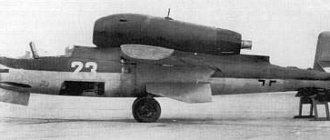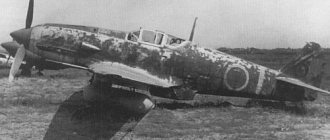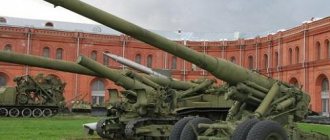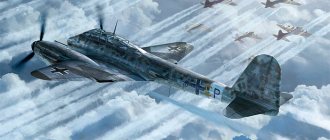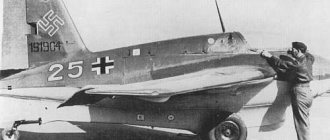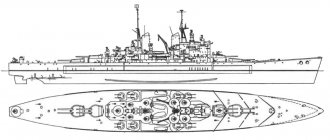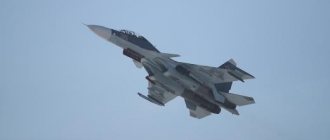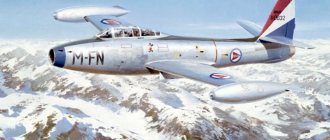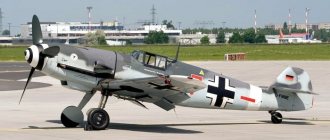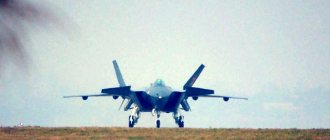The Hawker Tempest was a single-seat fighter aircraft, an all-metal monoplane with an enclosed cockpit and retractable tailwheel landing gear.
Under the leadership of S. Kemm, it was created in the design bureau. On February 24, 1943, the first prototype of the aircraft took to the skies for the first time. In June 1943, serial production of this aircraft began at Langley and Bristol in Filton. Out of production in June 1947, 1,257 Hawker Tempest aircraft were built over the entire period, of which 805 were built during the Second World War. From April 1944 it was in service in Great Britain, withdrawn from service in June 1953. Pictured are Hawker Tempest fighters
| Click on the photo of the plane to enlarge | |
The Tempest represented the pinnacle of heavy fighter development, but production volume was relatively small. By the time of mass production, new modifications of the Spitfire had already been produced, taking on the tasks for which the Tempest was designed.
During World War II, the following modifications of this aircraft were produced:
- Tempest V with Saber II engine;
- Tempest II with Centaurus V/VI engine;
- "Tempest" VI with a "Saber" V engine and an oil cooler in the wing.
Aircraft performance characteristics:
Tempest Mk.II
| Tempest Mk.II | |
| Engine: | |
| type | Bristol Centaurus V |
| power, hp | 2520 |
| Wingspan, m | |
| Aircraft length, m | 10,49 |
| Aircraft height, m | 4,42 |
| Wing area, sq. m | |
| Weight, kg: | |
| empty plane | 4040 |
| takeoff | 5360 |
| maximum takeoff | 6240 |
| Maximum speed, km/h / at altitude, m | 645/0 |
| 710/4360 | |
| Climb time 4572 m, min | 4’30» |
| Practical ceiling, m | 11430 |
| Flight range, km (with PTB) | 1295 (2640) |
(Continued. Started in No. 11,12/2007)
The first experimental “Tempest” V
Initially, “Tempest” traced its lineage to the project R. 1012 - “Typhoon” with radiators in the leading edge of the wing. The R. 1012 had an old wing, with a relative thickness of about 20%. This limited the aircraft's speed, and Camm took the next step, deciding to introduce a new thin, Spitfire-like wing with a relative thickness of 14.5% at the root. Hawker engineers designed this wing back in 1940.
The Typhoon II project envisaged combining this wing with the Typhoon I fuselage, an EC engine. 107 (later Saber IV) and narrow radiators in the wing. The Ministry of Aviation Industry approved the project in March 1941 and issued official assignment F. 10/41 for this aircraft. On November 18, the ministry ordered two prototypes of the Typhoon II.
At the beginning of 1942, the car was renamed “Tempest” - there were many things that distinguished it from the “Typhoon”. Even the fuselage could not be preserved in its original form: an additional gas tank was installed in it, which could accommodate fuel from the reduced wing tanks. Due to this, the length of the aircraft increased. Simultaneously with the renaming
KAZ was increased to six copies: one with the Saber IV engine (Tempest I), two with the Centaurus (Tempest II), two with the Griffons (III and IV) and one with the Saber II ( "Tempest" V, conceived as a backup option in case of failure with "Saber" IV). Without waiting for at least one of them to be ready, in August 1942, Hawker had already received an order for 400 aircraft.
As is usually the case, the spare Tempest V was the first to be produced. On September 2, 1942, F. Lukes took it into the air. The “five” had a new wing and, accordingly, a modified fuselage, but the vehicle had a power plant prepared for the later series of the “Typhoon” with a Saber II engine and a four-blade propeller. The test results forced two months later to increase the stabilizer and introduce a fork, which became characteristic features of all subsequent production Tempests.
The first experimental "Tempest" V with forkil. The cabin is like the first Typhoons - with a side door
The first experimental "Tempest" already with a new phonor, converted for testing as part of the work on "Tempest" VI
The second experimental Tempest V, used in test programs
Testing of 200-liter underwing tanks specially designed by the company
Cabin "Tempesta"
View of the Saber II engine
The experimental Tempest I took off only on February 24, 1943. The aircraft demonstrated a higher speed than the Tempest V - 750 km/h. But the fine-tuning of the Saber IV engine was delayed, and work on this modification was stopped, throwing all efforts at the new V model.
Instead of Tempest I, they decided to build in the Tempest V series. On June 21, 1943, tester B. Humble took off on the first production “five”. Production aircraft no longer had “car” doors, but a canopy – a “bubble” with a regular sliding section. The first 100 fighters, called Series I, had Hispano Mk guns. II with 200 rounds of ammunition per barrel (Typhoon had 140 rounds per gun). The cannon barrels protruded slightly from the wing. Later, on Series 2, Hispano Mk.V guns with shorter barrels were installed. A number of other minor changes have also been made. Even later, instead of the Saber IIA engine, they began to install IIB or IIC.
Experienced Tempest I on the ground and in the air
Tempests from the 501st Squadron
In August-December 1943, the first production Tempest V underwent military tests in Boscombe Down. At the same time, taking into account the experience of using the Typhoon, we tested various external suspensions - tanks, high-explosive bombs of 227 and 454 kg, improved missiles and a new product - napalm bombs. In April 1944, the fighter was considered suitable for combat use, and the first 50 were sent to Newchurch, where retraining of the 3rd and 486th squadrons began. By this time, about 250 cars had been produced. In June, the 56th was added to them, which delivered Typhoons. The wing created from these squadrons (150th) was headed by R. Beaumont, who had previously taken part in the Tempest tests.
The range allowed the Tempest to strike directly from Newchurch. The first combat missions took place a few days before the Allied landings on the beaches of Normandy. On June 8, over the Tempest landing area, four Bf 109Gs were shot down without losses and two more were damaged (the first aircraft was destroyed by R. Beaumont).
But after a relatively short period of using Tempests near the front line, they are switched to intercepting V-1 missile aircraft. The Tempest, the fastest English fighter (it flew faster than the Meteor jet), destroyed them with the highest efficiency. From June 1944, Tempests began regular patrols of the English Channel. By September, they had already destroyed 638 Fau (some sources even say about 800). By this time, five Tempest squadrons were involved in the hunt for flying bombs. One of them, the 501st, specialized in night interception: it had 61 V-1s. This squadron was the only one remaining in England until early 1945. All others were transferred to the continent starting in August 1944.
"Tempest" Kpostermona
The best French ace of World War II Pierre Klosterman in the cockpit of his Tempest
"Tempests" from Kpostermon's squadron at a Dutch airfield in the fall of 1944.
The Tempests were “just coming into full force” by the end of the war. At the front, they were used as multi-purpose vehicles: they accompanied bombers, bombed and fired at ground targets (primarily trains, small river and sea vessels), covered airfields, and also took part in raids to gain air superiority. The Tempest pilots accounted for 11 Me 262 jets shot down (the first was destroyed by R. Cole from the 3rd Squadron in November 1944). Lieutenant Varley from the 22nd Squadron shot down an Ar 234B reconnaissance aircraft in March 1945. However, Beaumont himself could not finish the war - on October 12, 1944, his plane was hit in the radiator, and he was forced to land behind German lines. Beaumont spent seven months in a prisoner of war camp.
On the morning of January 1, 1945, the Tempests were largely unscathed - they were picked up earlier and sent on their mission. The number of vehicles of this type at the front was constantly growing. They actively participated in the operation to cross the Rhine, and then in the final “cleansing” of the German skies from Luftwaffe aircraft. The last two Ju88s were shot down on May 3, and the last Tempest was shot down by the Germans the next day.
“Tempest” V remained in the occupation forces in Germany until the summer of 1946. After the war, some of the surplus “fives” were converted into TT.5 target towing vehicles: a winch was installed under the left wing. The first such Hawker aircraft was delivered in May 1947, and in June 1948 it fell into the hands of Air Force testers. Satisfied with the test results, the Ministry of Aviation issued an order for the modification of 81 fighters.
"Tempest" VI
"Tempest" VI
Experienced "Tempest" II
The Langley plant began this work in December 1948 and completed in May 1952. These aircraft were used in schools and training grounds until July 1955.
Tempest VI was a special modification for use in hot climates. It had a Saber V engine with 2340 hp. s, an enlarged radiator and an additional filter in front of the carburetor intake pipe (the intakes were moved to the wing). An additional oil cooler was installed into the leading edge of the right wing. The first prototype took off on May 9, 1944, and began testing in Khartoum (Sudan) in December. A series of 300 of these machines was ordered, 142 were actually built - the war was over. After the war, five squadrons in the Middle East and four in Germany received these vehicles. Tempest VI was based in Iraq, Cyprus, Aden and Palestine. They took part in several local skirmishes in Iraq, and then covered the withdrawal of British troops from the Ogaden (in Ethiopia) and Palestine. In the latter case, there was an air battle between Israeli Air Force fighters and Tempests escorting a British reconnaissance aircraft. One Tempest was shot down and three were damaged. One of these three is on the account of Ezer Weizmann, later the Israeli president. The last "sixes" were withdrawn from service in the spring of 1950.
Experienced "Tempest" II
Uncapped Tempest II engine
"Tempest" II with additional identification stripes of air forces prepared for battles against Japan
Tempest II was the result of a program to find an alternative power plant.
Centaurus was also tested on Tornado. Taking this experience into account, the Tempest was designed with a Centaurus IV engine. Its sample first took off on June 28, 1943 (piloted by Lukes). The car turned out to be quite successful, and they issued an order for 300 fighters, and then added the same number. But Gloucester was overloaded with contracts for Meteora and passed the order to Bristol.
Meanwhile, the tests continued. Dangerous vibrations from the engines emerged, but they were suppressed by the introduction of rubber boots. On September 18, the second copy of the “two” began flying. Engines of modifications IV, V, XII and XVIII were installed on it in turn, selecting the best one. In April-October 1945, three fighters were tested in Khartoum, assessing the possibility of service in a hot climate.
Bristol produced the first production Tempest II (with Centaurus V) at its Weston-super-Mare plant in September 1944. It was flown on 4 October. They wanted to equip the wing intended for the Far Eastern theater of military operations with “twos”. When the first squadron (54th) was being prepared, the war had already ended and it was stationed in Germany. Four more —
in India. The 33rd Squadron was sent to Hong Kong in 1949, and from there to Malaya, where it participated in Operation Firedog until 1951, fighting local partisans.
"Tempests" II from the occupation forces in Germany
Tempest V with Saber VI engine and frontal radiator
The same Tempest with an air intake in the propeller spinner that did not live up to expectations
"Tempest" with experimental installation of underwing 40-mm cannons
In Germany, the “two” survived until 1948. Since 1947, the aircraft were re-equipped with Centaurus VI engines.
That same year, the Indian government requested a shipment of 89 Tempest IIs. The planes were taken out of storage, subjected to careful inspection and sold. Before shipping, they had their lines and taps removed to allow the use of overhead tanks—the Indians considered them unnecessary. Then several batches were purchased directly from the company. A total of 233 “twos” served in India, which were equipped with 7 squadrons. From November 1946 to the end of 1953 they were used in combat units, and then for a number of years as training ones.
Tempest II from the Indian Air Force
Tempest II from the Pakistan Air Force
Lightweight "Tempest" - the future "Fury"
Tactical and technical characteristics of the "Typhoon" and "Tempest" aircraft
Pakistan received the same equipment. Pakistani cars corresponded to the standard version with the Centaurus V engine and outboard tanks. The first 24 aircraft arrived in September 1947. In total, the Pakistanis purchased 80 fighters of this type. Until 1953, three squadrons flew them, and the last Tempest II in Pakistan was decommissioned in 1958.
Just like the Typhoon, several modifications of the Tempest existed in single copies. On one car they installed an annular radiator, and then supplemented it with a large spinner with a central hole. At Boscombe Down in 1945, an aircraft with containers of 40-mm Vickers R cannons under the wing was tested. Each cannon had 38 shells.
Production of the Tempests was completed in June 1947. A total of 1,399 aircraft of this family were built.
To some extent, the successors of the Tempest can be considered the post-war fighters Fury and Sea Fury, work on which was carried out under the “lightweight Tempest” program.
Table of contents
Tempest Mk.V
| Tempest Mk.V | |
| Engine: | |
| type | Napier Saber II |
| power, hp | 2180 |
| Wingspan, m | 12,5 |
| Aircraft length, m | 10,26 |
| Aircraft height, m | 4,9 |
| Wing area, sq. m | 28,06 |
| Weight, kg: | |
| empty plane | 4090 |
| takeoff | 5180 |
| maximum takeoff | 6150 |
| Maximum speed, km/h / at altitude, m | 615/0 |
| 700/5180 | |
| Climb time 4572 m, min | 5′ |
| Practical ceiling, m | 11130 |
| Flight range, km (with PTB) | 1190 (2460) |
Combat use of Hawker Tempest aircraft
The introduction of Tempest Mk.V into combat units of the Royal Air Force was carried out slowly - by the beginning of the landing in Normandy in June 1944, only two AEs - the 3rd and 486th (New Zealand) - were flying them. The squadrons took part in combat operations over Normandy from June 8, but about a week later they were transferred to combat V-1 bombing aircraft. By the end of September 1944, these tasks were already carried out by 6 squadrons of Tempests, which by the end of the month had shot down 787 V-1 out of 1,771 projectile aircraft destroyed by fighters.
From the end of September 1944, 5 Tempest AEs, consolidated into the 122nd Wing, were hunting for Messerschmitt Me 262 jet fighters, trying to catch them during landing (in total, until the end of the war, there were Tempest pilots 11 Me 262 shot down). The 122nd Wing experienced its most intense air combat in December, during the German offensive in the Ardennes. Although the Typhoon was considered the main fighter-bomber of the Royal Air Force, Tempests were also used for strikes against ground targets, especially in January-April 1945. By the end of the war in Europe, Tempest pilots had 240 confirmed and 13 probable victories, own losses amounted to a little more than 100 aircraft (2/3 from anti-aircraft fire).
In the post-war period, Tempests were in service with the Royal Air Force until 1951. In particular, they carried out occupational service in the British Army of the Rhine, participated in battles against rebels in Malaya, served in India (before the declaration of its independence), as well as in the Middle East . Some of the aircraft were converted into Tempest TT.V (80 units) and TT.VI (2) target tugs.
India received at least 93 Tempest Mk.IIs, and 59 of these vehicles were delivered to Pakistan. Aircraft of both sides in 1947-1949. took part in the first Indo-Pakistani war. In both India and Pakistan, the Tempests served until the mid-50s.
The Tempest represented the pinnacle of heavy fighter development, but its production volume was comparatively small. By the time it was introduced into the series, new modifications of the Spitfire had already been produced, taking on the tasks for which the Tempest was designed.
Tempest Mk.VI
| Tempest Mk.VI | |
| Engine: | |
| type | Napier Saber V |
| power, hp | 2340 |
| Wingspan, m | |
| Aircraft length, m | 10,32 |
| Aircraft height, m | 4,9 |
| Wing area, sq. m | |
| Weight, kg: | |
| empty plane | 4150 |
| takeoff | 5250 |
| maximum takeoff | 6220 |
| Maximum speed, km/h / at altitude, m | |
| 705/5425 | |
| Climb time 4572 m, min | 4’42» |
| Practical ceiling, m | 11580 |
| Flight range, km (with PTB) | 1205 (2510) |
Main modifications of the Hawker "Tempest"
Tempest Mk . V - Saber II engine. The armament on most aircraft of the 1st series (consisting of 100 aircraft) was 4 20-mm British Hispano Mk.II cannons in the wing (ammunition capacity of 200 rounds per barrel). The rest of the aircraft received British Hispano Mk.V cannons - lighter, with shorter barrels, a slightly reduced muzzle velocity, but an increased rate of fire. It was allowed to mount two aerial bombs with a caliber of up to 454 kg or two PTB (205-l or 409-l), and when installing underwing guides - 8 76.2-mm NAR. Until June 1945, 800 aircraft were manufactured (of which 1 was converted into the Tempest Mk.VI prototype).
Tempest Mk.II - Centau-Rus V engine (2520 hp), armament - 4 British Hispano Mk.V cannons . The first production aircraft was ready in October 1944, but the production of the first production batch (50 aircraft built by Bristol) lasted throughout 1945. Since June 1945, this modification was built, which produced 402 aircraft until 1947. In 1947, the designation was changed to “Tempest” FB.2 for aircraft equipped with underwing units for NAR suspension, and “Tempest” F.2 for aircraft without such units.
Tempest Mk . VI - Saber V engine (2340 hp). In 1946-1947 142 aircraft were built.
